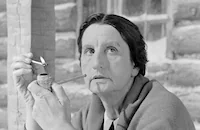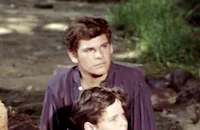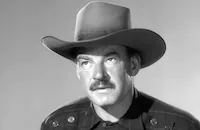The Guns of Fort Petticoat
Brief Synopsis
Cast & Crew
George Marshall
Audie Murphy
Kathryn Grant
Hope Emerson
Jeff Donnell
Jeanette Nolan
Film Details
Technical Specs

Synopsis
At the close of the Civil War, Lt. Frank Hewitt, a Texan who has joined the U.S. Cavalry, encounters a band of Cheyenne Indians who have illegally left the Sand Creek Reservation on a trading expedition. Because the Indians are unarmed, Frank's detachment merely orders them to return home. After Frank reports the incident to his superior, Col. Chivington, however, Chivington orders an attack on Sand Creek. Worried about Indian reprisals in nearby Texas, which because of the war is occupied mostly by women and children, Frank deserts his post and heads south. Along the way, he witnesses the brutal massacre of the peaceful Cheyenne people at Sand Creek. In Texas, Frank's warnings of potential Indian attacks go unheeded because of the uniform he wears. Even his old flame, Stella Leatham, who has since married, calls him a "damned Yankee." After citizen Dora Hartley is attacked in her home, however, Frank is put in charge of defending the town. He names Hannah Lacey, a tough widow who can shoot, as his sergeant. Aided by the reluctant "Kettle," an Irish-American cowboy, he and Hannah begin to drill the new "soldiers." Among others, the soldiers-in-training include Mrs. Ogden, a haughty dowager from Charleston, her black maid Hetty, dance hall entertainer Lucy Conover, and Ann Martin, to whom Frank is secretly attracted. Although Kettle has convinced the women they must go to a safer location, Frank is certain they will all be killed if they leave and sets the horses free. Frank then catches Kettle trying to steal their one remaining horse and imprisons him. Speaking tenderly from his jail cell to his sweetheart, Mary Wheeler, who is pregnant with his child, Kettle promises to marry her if she will release him. After she does, Kettle shoves her to the ground and escapes to a ranch house some miles away. There he encounters one Mexican and two American outlaws, who force him to reveal the location of the women and their jewels and money. Then Kipper, the outlaws' leader, shoots Kettle, and the bandits ride out to a nearby mission. When the women see them, they raise their rifles and order the men to leave. The outlaws ride into the countryside, encounter a large group of angry Indians and encourage them to attack the mission. The women hide on the roof, and the Indians, assuming the outlaws lied to them, fatally shoot the men. As the band rides away, however, young Bax stands up too soon and is spotted. Though short on ammunition, the women drive their attackers off. Later, Frank devises a plan and commands the women to place gunpowder "bombs" just outside the mission gates. The next morning, as the Indians attack, Sgt. Lacey and her troops fire their rifles at the bombs, causing them to explode and injure the Indians. In the resulting confusion, Frank finds the tribe's retreating medicine man and kills him, then returns to the mission with the corpse. Just as the ammunition runs out, the women hoist up the medicine man's body, causing the Indians to flee. Later, Frank returns to the Cavalry to face desertion charges, but Chivington refuses to believe that the women successfully defended themselves against hostile Indians. During the trial, Sgt. Lacey and her troops demand that Frank be released. The colonel is outraged, but the general states that the wrong man is on trial and arrests Chivington for his role in the Sand Creek massacre. As the women congratulate their former lieutenant, Ann approaches, and Frank embraces his new love.

Director

George Marshall
Cast

Audie Murphy

Kathryn Grant

Hope Emerson

Jeff Donnell
Jeanette Nolan
Sean Mcclory
Ernestine Wade
Peggy Maley

Isobel Elsom
Patricia Livingston

Kim Charney

Ray Teal

Nestor Paiva

James Griffith
Charles Horvath
Ainslie Pryor
Dorothy Crider

Madge Meredith
Pamela Baird
Evelyn Finley
Sharon Lucas
Helen Thurston
Willard Willingham
Frank Hagney
Hugh Sanders
Charles Meredith
Reed Howes
John Dierkes
Irene Barton
Francis Mcdonald
Edwin Chandler
Al Wyatt
Chief Geronimo Kuthlee
Crew
Mischa Bakaleinikoff
David Breen
George Brooks
Harry Joe Brown
Al Clark
Walter Doniger
Franklin Hansen Jr.
Gene Havlick
Henri Jaffa
William Kierman
John Livadary
Ray Rennahan
Abner E. Singer
Frank A. Tuttle

Photo Collections
Videos
Movie Clip



Film Details
Technical Specs

Articles
The Guns of Fort Petticoat
Murphy had started his own production company Brown-Murphy Pictures, Inc. with producer Harry Joe Brown and The Guns of Fort Petticoat was the company's first production. It would also be its last. When Murphy violated his contract with Brown by choosing his next film without consulting him, Brown sued and the partnership was dissolved.
Columbia acted as distributor for the film, which was also known as Petticoat Brigade. The Guns of Fort Petticoat was originally to be directed by screenwriter and television director Walter Doniger, but the better known George Marshall took over. Doniger's script, based on the short story Petticoat Brigade by C. William Harrison, was retained. The film was shot in Technicolor by the legendary Ray Rennahan (who had won an Academy Award® for Gone with the Wind, 1939). The Guns of Fort Petticoat was set during the Civil War in Murphy's home state of Texas, but was actually shot at the Iverson Ranch in Chatsworth, California, and at the Old Tucson Studios in Tucson, Arizona, between April 16 - May 18, 1956.
Audie Murphy stars as Union officer Lt. Frank Hewitt, who is ordered by his commander to massacre Native Americans at Sand Creek. Knowing this will only incite the tribe to take revenge upon American citizens; Hewitt refuses and deserts his unit. He returns to Texas, where he is considered a traitor for fighting for the Union, rather than the Confederacy. It is only when he gives them proof of an impending tribal attack that he is taken seriously. With the men away at war, Hewitt must train the women to defend themselves.
In the cast was the future Mrs. Bing Crosby, Kathryn Grant, supplying the love interest. While The Guns of Fort Petticoat was in production, Grant had been out on loan by Columbia to Universal for Mister Cory (1957), which was in pre-production. Grant was working double-duty in the spring of 1956, preparing for one film while shooting another, thanks to Murphy, who had brought Grant to the studio's attention after her test for The Guns of Fort Petticoat had been so successful. The always reliable Hope Emerson and Nestor Paiva provided support, along with Jeff Donnell, Jeanette Nolan, and Sean McClory rounding out the cast.
Audie Murphy, while only 5' 5" and slight, was a real-life tough guy. His bravery in wartime carried over into civilian life, and he had taken to hanging out with the LAPD and riding along with them on drug busts, having a particular hatred for narcotics traffickers. He would also go on busts with various police departments in Texas, receiving an honorary deputy sheriff's badge in Dallas. While he was in Tucson for location work on The Guns of Fort Petticoat, the star continued to pursue his after hours interests. Murphy spoke with a reporter on the set about the dangers of narcotics and admitted, "I have been accompanying officers on similar cases in various cities because I am interested, as every citizen should be, in stamping out the narcotics traffic and combating juvenile delinquency." Murphy would take part in many drug busts in Tucson, and as an auxiliary deputy sheriff in Pima County.
The Guns of Fort Petticoat premiered in Los Angeles on April 3, 1957, receiving decent reviews from the critics, like the Miami News' Herb Kelly, who noted all the clichés but found the film fun; "Calvary officer, bad men, a floozie pianist and whooping red-skins. One of the girls becomes hysterical and Audie slaps her across the jaw. He also slugs it out with a man twice his size and wins. Hope Emerson is the best in the picture. She's an old battleaxe appointed sergeant by Audie to train the women in shooting and Injun fighting. Murphy is likeable as usual, and Kathryn Grant, as the love interest, is rather sweet. Others in the cast fit into familiar patterns."
Producer: Harry Joe Brown
Director: George Marshall
Screenplay: Walter Doniger (screenplay); C. William Harrison (story)
Cinematography: Ray Rennahan
Art Direction: George Brooks
Music: Mischa Bakaleinikoff (uncredited)
Film Editing: Al Clark
Cast: Audie Murphy (Lt. Frank Hewitt), Kathryn Grant (Anne Martin), Hope Emerson (Hannah Lacey), Jeff Donnell (Mary Wheller), Jeanette Nolan (Cora Melavan), Sean McClory (Emmett Kettle), Ernestine Wade (Hetty), Peggy Maley (Lucy Conover), Isobel Elsom (Mrs. Charlotte Ogden), Patricia Livingston (Stella Leatham).
C-82m.
by Lorraine LoBianco>
SOURCES: >
Graham, Don No Name on the Bullet: A Biography of Audie Murphy
The Internet Movie Database
Kelly, Herb "The Guns of Fort Petticoat. Verdict: Women Give Indians a Permanent", The Miami News 19 Apr 57
Larkens, Bob and Magers, Boyd The Films of Audie Murphy
Parsons, Louella "Kathy Grant Stars with Tony Curtis" The Milwaukee Sentinel 18 May 56

The Guns of Fort Petticoat
Quotes
Trivia
Notes
The working title of this film was Petticoat Brigade. C. William Harrison's novel The Guns of Fort Petticoat first appeared in Collier's under the title of "Petticoat Brigade" (25 November-9 December 1955). According to a October 7, 1955 Hollywood Reporter news item, writer Walter Doniger was originally scheduled to direct the film. The Guns of Fort Petticoat marked the first production of Brown-Murphy Pictures, Inc., an independent production company owned by Harry Joe Brown and Audie Murphy.
Historical sources note that in 1861, Cheyenne and Arapaho Indians were forced onto the desolate Sand Creek Reservation in southeastern Colorado when gold prospectors poured into the state. In retaliation, these tribes launched attacks on the stagecoach lines to Denver. However, it was a band of peaceful Cheyenne, led by Black Kettle, who were attacked without warning on November 29, 1864, when Col. John M. Chivington led volunteer Colorado militiamen in what is now known as the Sand Creek Massacre. As many as two hundred Cheyenne, many of them women and children, were killed during the massacre. Chivington was later investigated by Congress and forced to resign.














